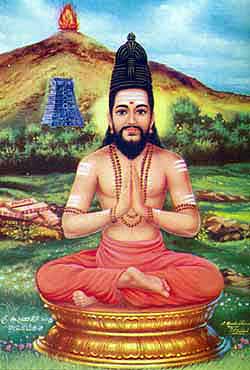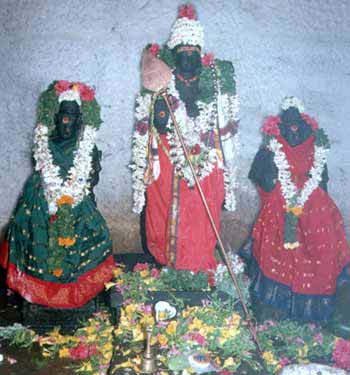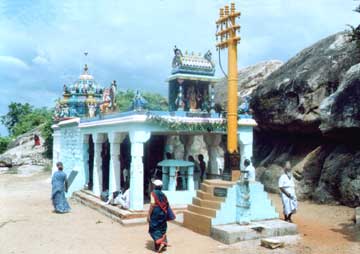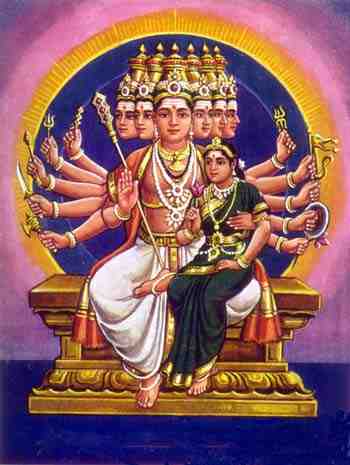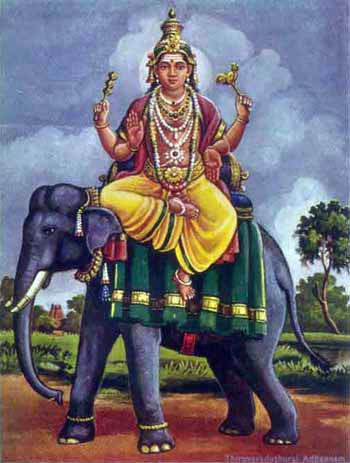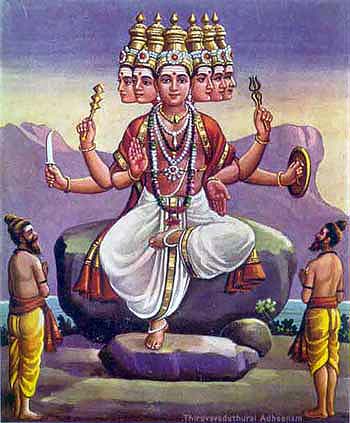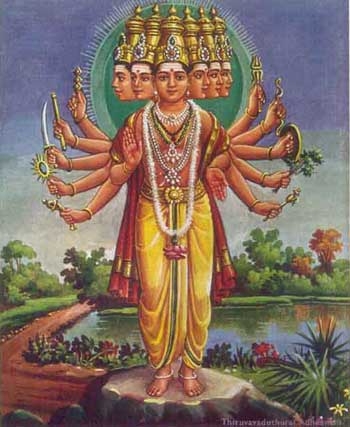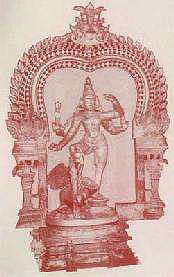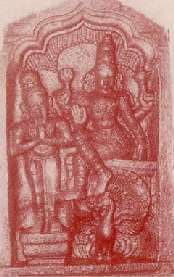
|
||||||||||||||||||||||
|
| ||||||||||||||||||||||
In the Footsteps of Saint Arunagirinathar:
|
| Saint Arunagirinathar at Tiruvannamalai |
Valayapettai Ra. Krishnan
Idol (mūrti), place (sthalam) and holy waters (tīrtham) have deep philosophical significance in Hindu Dharma. Our forefathers made it an important part of their life to travel to the sacred places and worship the gods in these places. Many Hindu saints made it their mission to travel from place to place and sing in praise of the gods in the village/town. They also performed miracles during these sacred journeys. Such places have acquired special significance by the visit of these great saints. The three famous Saivaite saints (tēvāra mūvar) have visited and sung in praise of God on about 275 temples, Vaisnava saints (alvārs) on about 108 temples, that are considered very sacred.
In the 14th century Saint Arunagirinathar, a great devotee who was blessed by Lord Murukan, was born and lived in Tiruvannamalai. He travelled throughout South India as well as some places in North India and Śrī Lanka, visiting many temples and singing in praise of Murukan. It is significant to note that Arunagirinathar sang exclusively in praise of Lord Murukan (Skanda). These sacred places are known as Tiruppukal sthalankal. His songs are rich and full of information about these places, their history, iconography, and contemporary living style, etc. For devotees of Skanda-Murukan and those who follow Lord Kumāra, Arunagirinathar's songs are considered to be sacred scripture -- nay the very words of the Lord Himself that sprang from Arunagirinathar's lips.
Tiruppukal manuscripts were unearthed by Śrī V.T. Subramania Pillai and published in 1894 and his son 'Tanikaimani' V.S. Chengalvaraya Pillai has written the commentry. This publication was in six parts under the name Murukanvel Panniru Tirumurai and is considered to be most authentic. In it he has made short references about the places visited and worshipped by Saint Arunagirinathar, but as he could not trace all the places, he left a few places as unidentified.
Based on the above works, my late brother Dr. R. Ramaseshan and I embarked on an extensive research mission about the Tiruppukal sacred places and published a detailed travelogue. This publication not only covers these sacred places but also their importance, Purana-Agama specialities, icons, relevant stone inscriptions and other data. Detailed maps are also made available for those who wish to see these places.
Of the 16,000 songs of Saint Arunagirinathar only about 1,329 are available today according to Tanikaimani. Some researchers give this figure as 1,361. In our studies we have adhered to the former assumption. Based on this, Arunagirinathar has sung in praise of Lord Murukan at 226 places. It is worth noting that out of these 226 sacred places 117 were also sung by the three great Saivaite saints. Out of these, 208 places have separate songs for each and the remaining 18 are referred to in the other songs.
These sacred places are spread over Tamilnadu, North India (four places), Andhra Pradesh (two), Karnataka and Kerala (one each) and Sri Lanka (three places). There are still eight places which cannot be clearly established. In our studies we have focused our attention on the following points in addition to writing an authentic travelogue.
- Re-examination of the places covered in Tiruppukal based on songs, places, history etc and propose changes;
- Establish the unidentified places;
- Unique or rare icons and sculptures in these temples.
I. Re-examination of the places covered in Tiruppukal based on songs, places, history, etc. and proposed changes
Since it was found that many places were having the same name, we had to examine in detail the contents of the song and other local data to establish the most probable shrines. The following are some examples of eight places appear to be the correct Tiruppukal shrines and differ from the ones mentioned by Tanikaimani.
- Nimbapuram: Nimba, a Sanskrit word, means 'Vembu' (Neem) and hence Tanikaimani identifies this place as Veppūr. He also refers to another information that there is a place as 'Nimbapuram' near Hampi, the capital of the famous Vijayanagar Empire. This village has been the victim of the fury of the river Godavari and reduced to paddy field by the floods, one hundred years ago.2 There is no temple at present.
- Kodumbai : Tanikaimani identifies this as Kodumbalur near Viralimalai in Pudukkottai District.3 When we search through literature, the names of some places may be called in short form. (e.g) Mylapur as Mylai., Tañjāvūr as Tañjai, Pondicherry as Putuvai; Ciruvāpuri as Ciruvai, and so on. In the same way Tanikaimani refers to Kodumbalur as Kotumpu. But after an extensive study this place was identified, which currently is called "Kodumbu".4 Six kilometres from Palakkad in Kerala, there is a beautiful temple for Lord Subrahmanya also known as Kalyāna Subramanya Temple, which is in Tamilnadu architectural style. It is also interesting to note that all the important festivals for Lord Subramanya are celebrated there,including the car (tēr) festival. The Kaikola Mudaliyars community who migrated from Kanchipuram are living in this place and are still conducting the weaving (handloom) business. Thus, this should be the kotumpai sung of by Saint Arunagirinathar in Tiruppukal.
- Muturantakattu-vata-tiru-cit-rambalam. This place is currently known as Pulipparakkōvil5 situated near Patalam (near Madurantakam). Tirukkalk Kunra Tala Pūrnam6 refers to this place as Viyakira Patapuram. Saint Vyakapatnar enjoyed the dance of Lord Natarāja as per his wish in this place and the Lord came to be known as Hema Sabesar which means 'Veda Ponnampalavan' in Tamil. Now the deity of this temple at Pulipparkkoil is known as Vyakrapurīsvarar and his consort as Balakujamba.7Saint Arunagirinathar worshipped at this temple and praised the Lord of Vada Ponnambalam as Vata-tiruc-cirrampalam (Ponnambalam and Chitrambalam are one and the same). There is another Tiruppukal in praise of Madurantakam Murukan as Madurantakam Manakaram Tikal Murukan and that temple at present known as Pantīcuvarar Kōvil in a paddy field near Madurantakam bus stand.8
- Karapuram: There are three Tiruppukal songs ending with the reference to Karapuram and two songs with Virincinal or Vrincinipuram. Tanikaimani opines that both Karapuram and Vrincinipuram are one and the same. There is a reference in Tiruvirincai Murukan Pillait Tamil by Marga Sanaya Devar that Vrincnipuram has been referred to as 'Karapuram' or 'Karapuri' and also in Vruncapuram Stala Purānam . But in our study we have established the present 'Tirupparkatal' near Kaveripakkam in Vellore District as 'Karapuram'. This temple known as "Karapurees Warar Temple" has the inscription of Partaventirati Verman (957-970 BC) who refers the Lord as Karapurattu Perumanatikal.10 Hence as per the present Tiruparkatal village should be the 'Karapuram' worshipped by Saint Arunagirinathar. The Śanmukha on peacock with Valli and Teyvāyanai seated on both sides at Karapurīcurara Temple is quite interesting to see as worshipped by Saint Arunagirinathar.
- Attipattu: There are many places in Tamilnadu under this name. According to Tanikaimani this place is near Gandarvakottai adjoining to Pudukkottai.11 However our studies confirm that the present temple at Neyveli township (Neyveli Lignite Corporation) known as 'Villudayanpattu' where Murukan with a bow in that temple is the one worshipped by Saint Arunagirinathar. This is the Attipattu under reference in Tiruppukal. The place is known as 'Villutayanpattu' at present because here Lord Murukan is armed with a bow. Revenue Department records show this as Attipattu and also with an exclusive shrine for Lord Murukan, which confirms our connection.12 In our extensive research there is no temple in other places by the name 'Attipattu'.
- Nallūr: We have confirmed this place near Papanācam in Tanjavur District. This temple, known as Kalyānacuntarēcuvarar temple, was constructed by Kocenkat Colan where Lord Tyagarāja of Rituvarur stayed for three days according to the sthalapurānam of this Nallūr.13 This particular reference has been cited in Nallūr Tiruppukal song by Saint Arunagirinathar as Cankara Tiyākar Vanturai Nallūr that Lord Tyāgarāja's stay confirm that this is the place referred by Saint Arunagirinathar. Though Tanikaimani has given reference of Nallur near Papanācam,14 he establishes the Nallūr as Accarpuram near Chidambaram, where Tiru Jñāna Sambandhar was married.15 Here the deity of this temple is known as Śivaloka Tiyākēcar. Though this deity's name is in association with Tiyākēcar, Papanasam Nallur gives the reference of Lord Tyāgarāja of Tiruvārūr episode, which as per the version of Saint Arunagirinathar's Tiruppukal lines coincides with this place and hence we confirm that Nallūr near Papanācam is the said Tiruppukal shrine.
- Kīranūr: Tanikaimani refers to Kīranūr near Palani on the way to Dharapuram as the Tiruppukal shrine.16 But in our findings there is no cannatti of Lord Murukan in this Kīranūr Temple. We have identified are Kīranūr near Mayilatuturai (near Tiruppariyalūr, one of the famous astavrata sthalams where the presiding deity is known as Śivalokanāthar and His consort Bālambāl alias Ksīrambāl.17 This temple is of Chola period. Ksīram means milk. In Tamil it is written as kīram. The goddess of this temple known as Ksīrambāl means Goddess of Milk and the place is known as the place of milk Ksīranūr or Kīranūr. There is also the episode of Tiruppālkatal (Sea of Milk) described in the Kīranūr Tiruppukal as an added proof for our contention.
- Kuritimalai: Tanikaimani confirms this place near Tutiyalūr in Coimbatur District.18 But through onsite research, we determined that the hill near Tutiyalūr is not Kurutimalai and there is no temple. But this hill has been identified near Cima Tatakam. The local village administrative office and some old people of this village confirm that this hill is Kurutimalai.19 After five miles walk on the hill, there is a temple for Visnu which is said to have been a temple for Murukan some fifty years back. There is a stone pītham which confirms this.
II. Establish unidentified places
We have established the following places against some of the unidentified places mentioned by Tanikaimani.
- Vicuvai: This place was identified as Vicūr near Utimērūr in Kanchipuram District.20 Here there is a temple for Śrī Agastīcuvarar-Akilantēcuvar. Here the Goddess shows her visvarūpa and hence this place is known as Vicuva Manakar, which is short-formed as 'Vicuvai'. There is a beautiful idol of Murukan with Valli and Teyvayānai. The epigraphy inscriptions of King Rāja Rāja I (AR 387 of 1923) have been deciphered in this temple. There is no other place by the name Vicūr or Vicuvai in our survey and hence this place should be regarded as the Tiruppukal shrine.
- Mulvoi: Near Arkonam in Velur District, a place known as Mulvoippalayam exists, and there is every possibility that this place is the Tiruppukal shrine, since no other place by this name exists.22 Unfortunately there is no temple for Lord Murukan or Śiva at present here. The people of this village hold that some years ago when they dug the earth for construction of a tank they found part of temple pillars, but have not completed their excavation. Hence at present there is no sign of a temple here.
- Kāmattūr:
Near Arni in Velur District there is a place by name
Kamakkūr.23 There is a Śiva temple by name Śrī Candrashekara Swāmi and His consort Śrī Amirtāmpikai. There is a
separate shrine for Devi Kāmāksi. Since this temple is associated with the name Kāmāksi,
the river is 'Kāma Nati', the sthala purānam is 'Kāma Nagar Purānam' and we can
easily came to the conclusion that Kāmattūr and Kāmakkūr are one and the same. The
ancient temple belongs to Cola period, where Lord Sanmukha with six faces and twelve hands
is seated on the peacock vahanam with Valli and Teyvayānai by his side are very
beautiful. (This same type of Sanmukhacan be seen in Kanakagiri temple (Devikāpuram), also
a Tiruppukal shrine.24 In our survey we did not come across any other place by the
name Kāmakkūr.
Jñānmalai Valli Teyvanai Samedha Murugan Jñānmalai Śrī Bāla Subramanya Kovil - Vakai Manakar: Tiruvaloliputtūr the abode of Lord Śiva, praised by Tiru Jñāna Sambandhar and Sundarar in Tēvāram hymns, is currently known as Tiru Valapattūr.25 This place is near Pantanallūr and 16 kilometres away from Mayilatuturai. It is interesting to note that a vakai tree is the sthala vrksam; hence Arunagirinathar refers to this place as Vakai Manakar (for Tirukkalimunram). The sthala vrksam is the plaintain, which Arunagirinathar refers as katali vanam (katili means plaintain).26 Likewise this place has been referred as Vakai Manakar. Mahāvidvān Śrī Mīnaksisundaram Pillai (of Tiruvāvatuturai Atīnam) has written the sthala purānam for Tiruvallōliputtūr in which he refers to this place as Vakaimanakar. The temple is dedicated to Lord Ratnapurīsvaran. Hence one may conclude that this place is the Tiruppukal shrine.
- Jñānmalai: Arunagirinathar praises the Lord of Jñānamalai in two Tiruppukal songs and by his grace this place was traced out near Kevaipakkam in Velur District. The village by name Kōvintaceri midway between Kaveripakkam and Cōlinkar, has a small hillock on which there is a small Bālasubramanya Swāmi temple.27 Here Lord Murukan shines in 'BrahmĀ Śastā' pose holding rudrāksa māla and kamandalu with Valli and Teyvayānai on both sides. The idol with karanta makuta is from the Pallava period. Arunagirinathar praises the glory of Lord of Tiruvannamalai, who has shown His feet and granted blessings. The idol, which is partly damaged, was deciphered recently. Kalikarayan (1322-1340 AD) a chieftain of Tantai Mandalam during the reign of Campuravayars Rāja Narāyanan I and Rāja Jarayanan II, constructed the steps for Jñānmalai Murukan temple, as referred in the inscription. Hence this is an important hill abode of Lord Murukan which was visited and praised by Arunagirinathar.
III. Unique or rare icons and sculptures
In many of the temples visited by Arunagirinathar there are rare or unique icons and sculptures. We find various form of the images of Murukan which are not to be found in any of the sculptural texts. They are so handsome that the mind is attracted by the beauty and the body becomes emotionally ecstatic. We lost ourselves completely upon seeing these images.
Let us see some of these rare forms.
- Mayilāpūr: Vanap Pitiyum Kanakap Pitiyam
(Teyvayānai and Valli seated on elephants).
This peculiar form of both Teyvayānai and Valli seated on elephants separately can be found only at Mylapore Kapalīshwarar Temple.28 Devasenā is the daughter of Indra and was brought up by Iravata, his elephant; hence it is appropriate that she is seated on an elephant vehicle, which is not a surprise. But Valli who ran in fear when the elephant (Vināyaka) approached her, is now seated coolly on an elephant. It came as a surprise to us, and is a testimony to the imagination of the sculptor. Here Lord Cinkāravēlar is seated majestically on the peacock with six faces and twelve hands. Such a form of the consorts of Murukan seated one elephants is a singular feature to be noted and appreciated by all. We find no reference to such a peculiar set-up either in the Agamas or in the shoilpa shāstras. In this connection it may be noted that Murukan also has his elephant vehicle in Pini Mukam. - Ciruvāpuri "Valli manavālap
perumāl" (Valli Kalyana Sundarar)
Among the various names of Murukan, the name Valli Kanavan stands supreme as the famous one. Murukan, who is the consort of Teyvayānai, the celestial daughter of Indra, married a huntress-girl of this human world, an aspect having very deep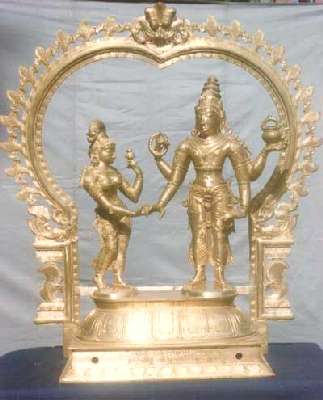 philosophical significance. All are equal in the face of God and this is the expression of the
Vallināyakam form.29 Valli shines in brilliance here as Ichhā Śakti. The marriage of Murukan
with Valli is eulogised by Tamil scholars as a most fitting example of 'furtive love'.
(kalavu manam). Murukan married Valli and enjoyed conjugal bliss with her with a smile
always. This is indicative of how the householders' life should be led in this mundane world.
His image of wedlock with Valli is known as
Valli Kalyāna Sundarar. The Kumāra
Tantra depicts this form as having one face and four hands. The front two hands are one
in abhaya mudrā and the other in Kadyavalmpītham (hand placed on the hip). In the
back two hands he has rudraksa māla and kamandalu. In this form on the right side we
find Valli in all her beauty.
Lord Murukan holding the hand of Valli in preparation for wedlock
is only the one of its kind at Ciruvāpuri Śrī Bālasubramanya Svāmi Temple (35 kilometres from Chennai
at Gummudipoondi [GNT Road] Route 30).The worship of Valli Kalyana Sundarar
paves the way for the celebration of marriages at the proper time among families. Even
marriages which have been thwarted by circumstances are said to get relieved of obstacles,
paving the way for happy married life.
philosophical significance. All are equal in the face of God and this is the expression of the
Vallināyakam form.29 Valli shines in brilliance here as Ichhā Śakti. The marriage of Murukan
with Valli is eulogised by Tamil scholars as a most fitting example of 'furtive love'.
(kalavu manam). Murukan married Valli and enjoyed conjugal bliss with her with a smile
always. This is indicative of how the householders' life should be led in this mundane world.
His image of wedlock with Valli is known as
Valli Kalyāna Sundarar. The Kumāra
Tantra depicts this form as having one face and four hands. The front two hands are one
in abhaya mudrā and the other in Kadyavalmpītham (hand placed on the hip). In the
back two hands he has rudraksa māla and kamandalu. In this form on the right side we
find Valli in all her beauty.
Lord Murukan holding the hand of Valli in preparation for wedlock
is only the one of its kind at Ciruvāpuri Śrī Bālasubramanya Svāmi Temple (35 kilometres from Chennai
at Gummudipoondi [GNT Road] Route 30).The worship of Valli Kalyana Sundarar
paves the way for the celebration of marriages at the proper time among families. Even
marriages which have been thwarted by circumstances are said to get relieved of obstacles,
paving the way for happy married life.
- Kankakiri (Devikāpuram) Senāni (Senāpati)
In the Gīta, Lord Krishna says to Arjuna that among the heroes Skanda shines as the generalissimo among warriors (senāni, i.e. Murukan). Those who want to be heroic warriors worship this form of Murukan. Chanakya in his Artha Śastra mentions the figure of Senāni on the ramparts of the Maurya kings.31 Murukan was directed to be the Commander-in Chief by Śiva when the devas approached him with a request to conquer and eradicate Surapadma. So he is called Senātipati' (Generalissimo). This image has six faces with twelve hands as per Kumāra Tantra. Of the six right hands, one is in the abhaya mudrā, while the others hold the thunderbolt, lotus flower, noose, club and mace. We can find the Senāni image in the temple of Peryianāyaki Amman in Devikāpuram, Tiruvannamali District. - Amirtakāra Subramanyar Koti Kulakar Kōvil
Murukan is seen with a pot of amrta in his hand ready to shower His grace and distribute this amrta to the devotees who seek his succour. This form is singularly unique and can be seen at the Kulakar Kovil in Kodikkarai adjacent to Vedaranyam in Tañjāvūr district.44 Here Murukan has one face and six hands with a huge body seated the peacock and by the two sides we find both the devis. The right had is in abhaya mudrā and in the left hand he bears the pot of amrta. In the other hands we find respectively, śaktivēl, lily flower, thunderbolt and lotus flower. - Cennimalai Agnijātar (Cennimalai near Erode)
This form is specially to be noted. Nakkirar in Tiru Murukārruppatai refers to this form in the Orumukam Mantira Vitiyin Marapuli Vala Antanar Vēlvi Orkkumme. Thus for igniting the divine sacrificial fire, this form is depicted with two faces resembling Agni, with eight hands. We find thunderbolt, cock, shield, ghee vessel, suruva (the laddle for pouring ghee into the sacrifical fire) rudraksa māla, sword and svāstika (a weapon thrown at the enemies after spinning it fast) Śrī Tattva Nidhi depicts this image as one sitting to do a sacrifice (yāga). But at Cennimalai we find this special image in the standing pose.32 Such a one is not seen anywhere else. Those who worship this receive all the benefits accruing from the performance of a yāga.Devasenāpati Gajavāhana Kārttikeya Tārakāri (Slayer of Tāraka) 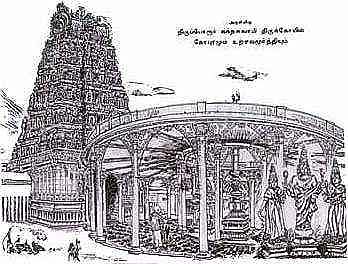
Tirupporur Kandaswami Kovil Mandapam Tiruppōrūr: Samharamūrti (left) and Murugan expounding the meaning of Pranava to Agastya Muni (right) - Saurabeya Subramanyar
The Śrī Tattva Nidhi refers to this divine form with four faces and eight hands. In this form the right foot of Murukan stands straight upon the earth while the left foot is slightly bent. Of the four right hands one is in the varadā pose, and in the remaining three hands he holds the thunderbolt, a bow of sugarcane, and trident. This Saurabeya form can be seen only at Cennimalai.33 - Devasenāpati
This term means Murukan, the consort of Devasenā. Devasenā is the daughter of the daughter of Indra, but brought up by Iravata, his elephant. Hence she came to be called Teyvayānai ('divine elephant'). She was given in marriage to Murukan by Indra at Tirupparankunram (near Madurai). The Kanta Purānam dedicates an entire patalam (chapter) to the descriptionof the divine marriage. In the form of Devasenāpati, Murukan is depicted as possessing six faces and twelve hands. Teyvayānai is embraced by Murukan with one hand on the left side. Another hand is in the abhaya pose. In the remaining ten hands, he holds the following weapons: śakti, trident, arrow, sword, club, thunderbolt, cock-flag, bow, shield and lotus flower. According to Śrī Tattvanidu, Devasenāpati's form is depicted with one face, two eyes and four hands. Two hands are in the abhaya mudrā and varadā poses and in the other two he holds the conch and disc. This peculiar image is enshrined in Cennimalai.34 - Chidambaram: Gajavāhanar (Kallrrurtip-perumāl)
In this form Murukan has as his vehicle the elephant. Hence he is called Gajavāhanar and Gajārudhar. This sort of 'elephant vehicle' is usually found in ancient temples dedicated to Murukan, just in front of the mūlavar. For example, we find this peculiar feature at Tiruttani, Swāmimalai, and Uttiramērūr. The Kanta Purānam mentions that 'Iravatam of Indra' acted as the vehicle for Murukan. Whenever Murukan goes for battle or for showering grace he goes on his elephant called Pini Mukam. Arunagirinathar in the Tiruppukal sung at Chidambaram praises the Lord as unrantuc cintai Santhoshit Talu Kontarula Vantu cinturat-tēri (cinturam elephant). The Kumāra Tantram refers to this form of Murukan with one face and four hands. They are with the weapons śakti and cock in two hands while the others are in the abhaya and varada poses. As per another reference, he is holding the Vel and the sword in his two right hands and the cock-flag in both the left hands. The gateway of the eastern gopuram at Chidambaram bears a beautiful image of this Gajārudhar and Arunagirinathar refers to this deity in appropriate words. 35 - Kumbakōnam: Kārttikeya
This name is common in North India. Because Murukan was brought up by the Krttikā maidens, he is known as Kārttikeya. The Kumāra Tantra depicts Kārttikeya with six faces and six hands. Two hands are in the abhaya and varada poses and in the remaining four hands he bears the weapons of śakti, sword, thunderbolt, and shield. He is said to shine like the morning sun. The Tanikaip Purānam gives the description of the Kārttikeya form. Murukan has six faces and six hands, of the left three hands, one is in the varada mudrā and in the other two hands he bears the thrunderbolt and shield. Of the three right hands, one is in the abhaya mudrā and in the other two hands he bears the spear (Vel) and the sceptre (cenkkōl). Those who concentrate upon this aspect will be relieved of all diseases. This form of Murukan is shaped to represent Kārttikeya. At Adi Kumbeshwarar Kovil in Kumbakonam, Kārttikeya shines with six faces and six hands.36 In four hands, he has the japa māla, sword, thunderbolt and shield; the right hand is in the abhaya pose and the left is bent. - Uttiramērūr: Tārakāri" (Slayer of Tāraka)
Tārakāsura was the younger brother of Surapadman. He was an adept in in deluding his enemies through his Māyā. When Deva, the chief among the nine heros (nava vīrar) associated with Murukan, entered into the hill region, Tārakāsura mesmerized them and made them to swoon. When Murukan came to know about this magical delusion made by Tāraka, he made his Māyā useless by throwing his Jñāna Vēl and disposed of Tārakāsura once and for all. This is mentioned in the line Kuruku Pēyariya Kunram Konron Murukan. Kuruku stands for krauñcam (Skt: stork). In Kumāra Tantra this form of Murukan is depicted with six faces and twelve hands. One of his right hands is in the abhaya pose and in the rest five right hands, he bears śakti, the pestle, sceptre, disc and noose. One of the left hands is in the varada pose, and in the remaining five left hands he holds the thunderbolt, bow, shield, creeper and a demigod. This Tārakāri image is in Virālimalai mūlasthānam. The Tanikaip Purānam also corroborates the Kumāra Tantra description. We find this same image at Uttaramērūr Murukan temple in Chengleput district.37 - Tiruppōrūr Deshikāsubramanyar
This is the Śivaguru form. Śiva is said to be seated under the banyan tree to give upadesha to saints (Sanakan, Sanātanan, Sanatkumāran and Sanāntanan). Here we find Murukan giving upadesha to Śiva Himself, who enlightened those saints. Hence Murukan is called Jñāna Deshika. The Deshika Subramanyar form is depicted with one face and six hands. In two hands he holds śakti and in the other four rudraksa māla, abhaya and varada and cin mudra. Śiva is depicted as standing before Murukan as a student to receive the Pranava upadesha. In the Mana Cara book we find a different form mentioned for this. Deshika Subramanya Śiva stands before Murukan with the left hand placed on the chest and right hand placed on the mouth as a sign of obedience to the Guru; and in other two hands we find the udukkai, a small drum tapering in the middle and a stag. The crescent moon shines on his head and Pārvatī Devi is seated on his left side. This is a unique pose in which Śiva as a student revieved upadesha from his son. We find this form in a beautiful bronze image at Tirupporur.38 In this image Murukan sat on the lap of Śiva on his left leg bent, while the right leg is placed on the pedestal. Śiva is embracing Murukan with one of his left hands; on the other left hand he holds the stag. Of the two right hands one is holding the battle axe, while the other is taken near his mouth as a symbol of obedience. This image of Śivagurunātha as upadesha mūrti is singularly unique and it is a sight for the gods themselves to behold. Murukan also gave upadesha to Agastiya, BrahmĀ, Visnu, Indra, Saptarsis and the four saints (Sanakan, et al.) This can be evidenced by Tiruppukal of Arunagirinathar. - Ajārudhar (Āttu Vāhanar)
This is called the Ajārudhar form in which Murukan is depicted as seated on a goat as His vehicle. The story is that the goat which emanated from the yāga performed by Narada began its work of destruction and the devas represented this to Murukan. Murukan sent his lieutenant Vīrabāhu to catch the goat and bring it to him. Vīrabāhu did as commanded and Murukan sat upon the goat using it as a vehicle. The Kantar Kalivempa speaks of this in one stanza. We can see this rare form of Ajārudhar image at Kanda Swami Kovil, Tiruppōrūr. - (c) Kumpamuni Kumpitum: Tampiran
There are three individuals who received upadesa directly from Murukan, namely Śiva, Agastiya and Arunagirinathar. Arunagiri makes mention of Murukan as a teacher who taught the three kinds of Tamil iyal, icai and nātaka. This form of Murukan in the upadesa pose is inscribed on a pillar in the mandapam at Tiruppōrūr Kanda Swāmi Kovil. 40 - Tiruvitak-kali : (Villantiyavēlan)
Murukan, like his maternal uncle Visnu (in His Rāma avatāra) bears the bow Kottantam as evidenced by Arunagirinathar's expression venkopa Kottantam (Tiruppukal stanza 1107). In the Tiruccentūr Tiruppukal, we find mention of Kottantam. "Oh, Murukan with trident, club, cock and Kottantam bow in four hands and with anklets on four feet, with a broad chest and seated on your peacock, you must give darshan to me." Murukan with the bow is known as Samhāra Mūrti. The form taken by Murukan to kill Hiranyāsura, the son of Surapadma, is called Hiranyāsura Samhāra Mūrti. We can see this form at Tiruvidaikali (near Tirukkadavur) hallowed by Sentanar's Tiruvicaippa.41 In some stalas we find Samhāramūrti with his two consorts Valli and Devasena while in other stalas he stands alone. In pañcaloha idols this form of Murukan holding the bow is shown as if his left leg is placed on the peacock. In the front right hand he holds the arrow and in the front left hand he holds the bow; in the other two hands he holds śakti and thunder bolt. Such forms of idols can be seen at Tirupporur, Tiruvenkātu, Cēyūr,Śivapuram and Śrī Mushnam. - Valuvar: Parivutan Kauri Koñcum Bālan
Mother Parvati fondles the child Murukan by embracing him with her right hand in an exquisitely beautiful pose. This bronze image captivates the eye. The Ambigai is called Guhāmbigai. This is at Valuvur.42 There are also beautiful images of Gaja Samhāran, Bhiksādanar, and Mohini at Valuvur, which is on the way to Manganallūr near Mayilattuturai. Here these lines of Arunagiri can be noted with advantage:Ati Cankanar Paka Matumai
Kola Ampagai Mata Monomani
Ayi cuntari Tāyana Nārani Apirāmi
Aval kontu virale ciratavē
(Potakantaru... Tiruvavinankuti Tiruppukal)] - Kalukumalai: Kalugu Malaiyil Alaku
Mayil (The beautiful peacock vehicle at Kalukumalai with Murukan
seated on it.)
We have to go to Kalukumalai near Tirunelveli to see Murukan with one face and six hands seated on the Peacock facing the left side of Murukan.43 Of the six hands two are respectively in the abhaya and varada poses and in the other four hands he holds the śakti (Vēl), aword, thunderbolt and ahield. Arunagirinathar mentiona Kalugulamalai in the lines:"Ventum Atiyār Pulavar Venta Ariyaporulai
Ventum Alavil Uthavum kalukumalai Vallal"Bibliography
- Chengalvaraya Pillai, Dr.V.S.C. Murukanvēl Panniru Tirumurai, (Madras: Meenakshi Kalyana Sundaram) 1954.
- R. Ramaseshan, Dr. R. and Krishnan, R. Arunakirinātar Ati Cuvattil. (Swamimalai Tirukkovil) 1981.
- Narayanaswami, V. Tamilaka Arputa Alayankal (Madras: Narmata Pattippakam) 1989.
- Ten Intiya Tamil Cācanankal. Caiva Sittānta (Madras: Nūr Pattippuk Kalakam) 1967.
- Tirunallūr Tala Purānam. (Tiruvavaduthurai Adheenam) 1971.
- Ramasesnan, Dr.R. and Krishnan, Ra. Mulukum Alakiya Kumaran (Madras: Tiruppukal Pattippakam) 1987.
- Krishnan, Ra. Varam Arulam Ciruvai Murukan (Chennai: Ciruvacirc;puri Murukan Abhisheka Committee) 1994
- Murukavēl Panniru Tirumurai published by Meenakshi Kalyana Sundaram in 1952.
* Both Tanikaimani and Kirupānanda Variyar editions
* Saiva Siddhanta Mahā Samajam 1935 edition.
End Notes
- Murukanvēl Panniru Tirumurai, Vol. IV p. 258
- Arunakirinātar Aticcuvattil, p. 560
- Murukanvēl Panniru Tirumurai, Vol. IV p. 772
- Arunakirinātar Aticcuvattil, p. 562
- Arunakirinātar Aticcuvattil, p. 84
- Tirukkaluk Kunra Talapurānam, Chapter 22
- Tamilaka Arputa Alayankal
- Arunakirinātar Aticcuvattil, p. 83
- Murukanvēl Panniru Tirumurai, p. 44.
- Ten Intiya Tamil Cācanankal, pp. 21-30.
- Murukanvēl Panniru Tirumurai, Vol IV p. 622.
- Arunakirinātar Aticcuvattil, p. 157.
- Tirunallūr Tala Purānam, Chap 25.
- Murukanvēl Panniru Tirumurai, Vol IV p. 282.
- Murukanvēl Panniru Tirumurai, Vol IV p. 280.
- Murukanvēl Panniru Tirumurai, Vol IV p. 774.
- Arunakirinātar Aticcuvattil, p. 420.
- Murukanvēl Panniru Tirumurai, Vol II p. 496.
- Arunakirinātar Aticcuvattil, p. 200. and interview with Śrī Kushma Cettiar, Natarajan and Palani Cuvāmi of Cinna Tadagam.
- Arunakirinātar Aticcuvattil, p. 81.
- Arunakirinātar Aticcuvattil, p. 110.
- Arunakirinātar Aticcuvattil, p. 112.
- Arunakirinātar Aticcuvattil, p. 114.
- Arunakirinātar Aticcuvattil, p. 321.
- Arunakirinātar Aticcuvattil, p. 76.
- Dinamani Kathir supplement, 29 November 1998, pp. 22-23.
- Mulutum Alakiya Kumaran, p. 88.
- Mulutum Alakiya Kumaran, p. 55.
- Varam Arulum Murukan, p. 12.
- Mulutum Alakiya Kumaran, p. 51.
- Mulutum Alakiya Kumaran, p. 62.
- Mulutum Alakiya Kumaran, p. 63.
- Mulutum Alakiya Kumaran, p. 37.
- Mulutum Alakiya Kumaran, p. 40.
- Mulutum Alakiya Kumaran, p. 44.
- Mulutum Alakiya Kumaran, p. 51.
- Mulutum Alakiya Kumaran, p. 65.
- Mulutum Alakiya Kumaran, p. 71.
- Mulutum Alakiya Kumaran, p. 81.
- Mulutum Alakiya Kumaran, p. 66.
- Mulutum Alakiya Kumaran, p. 83.
- Mulutum Alakiya Kumaran, p. 86.
- Mulutum Alakiya Kumaran, p. 70.
Valayapettai Ra. Krishnan is a prominent Muruka devotee and scholar in the Chennai area having a large number of Tamil publications to his credit. He has also produced many audio cassettes, musical discourses and lecture demonstrations. His spouse T.V. Sundaravalli is a renowned vocal recording artiste specialising in Tiruppukazh and Muruga bhakti songs.
Valayapettai Ra. Krishnan
52, Muthaiah Mudali II Street
Rayapettai Chennai 600 014 India
E-mail: s_sundaram@vsnl.net
Telephone: (091) 44 847-4468
